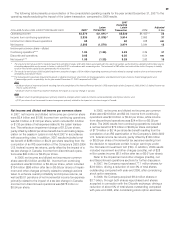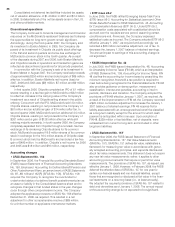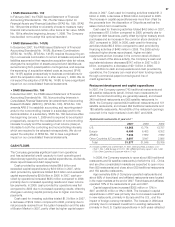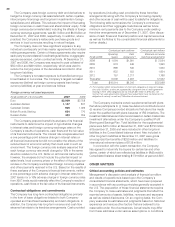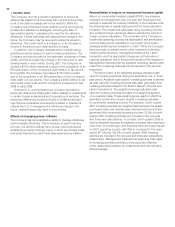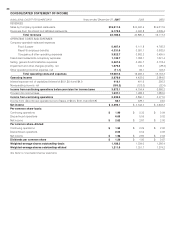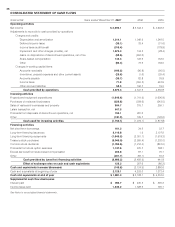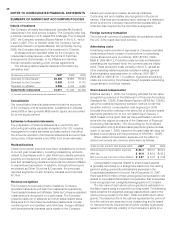McDonalds 2007 Annual Report Download - page 41
Download and view the complete annual report
Please find page 41 of the 2007 McDonalds annual report below. You can navigate through the pages in the report by either clicking on the pages listed below, or by using the keyword search tool below to find specific information within the annual report.
Impairment and other charges (credits), net reduced/
(increased) return on average assets by 5.4 percentage points,
0.4 percentage points and (0.2) percentage points in 2007,
2006 and 2005, respectively. In addition, these items along with
the 2007 and 2005 net tax benefi t resulting from the completion
of IRS examinations and incremental tax expense in connection
with HIA, reduced/(increased) return on average common equity
by 8.5 percentage points, 0.6 percentage points and (0.5)
percentage points in 2007, 2006 and 2005, respectively.
In 2007 and 2006, return on average assets and return on
average common equity both benefi ted from strong operating
results in the U.S. and Europe, as well as improved results in
APMEA. During 2008, the Company will continue to concentrate
restaurant openings and new capital invested in markets with
acceptable returns or opportunities for long-term growth.
Financing and market risk
The Company generally borrows on a long-term basis and is
exposed to the impact of interest rate changes and foreign
currency fl uctuations. Debt obligations at December 31, 2007
totaled $9.3 billion, compared with $8.4 billion at December 31,
2006. The net increase in 2007 was primarily due to net issuances
of $573 million and the impact of changes in exchange rates on
foreign currency denominated debt of $342 million, partly offset
by Statement of Financial Accounting Standards No. 133,
Accounting for Derivative Instruments and Hedging Activities
(SFAS No. 133) noncash fair value adjustments of $23 million.
Debt highlights
(1
)
2007 2006 2005
Fixed-rate debt as a percent
of total debt
(2,3)
58% 49% 46%
Weighted-average annual
interest rate of total debt 4.7 4.1 4.1
Foreign currency-denominated
debt as a percent of total debt
(2,3)
66 80 80
Total debt as a percent of total
capitalization (total debt and
total shareholders‘ equity)
(2)
38 35 40
Cash provided by operations
as a percent of total debt
(2)
53 52 44
(1) All percentages are as of December 31st, except for the weighted-average annual
interest rate, which is for the year.
(2) Based on debt obligations before the effect of SFAS No. 133 fair value adjust-
ments. This effect is excluded, as these adjustments have no impact on the
obligation at maturity. See Debt fi nancing note to the consolidated fi nancial
statements.
(3) Includes the effect of interest rate and foreign currency exchange agreements.
Fitch, Standard & Poor’s and Moody’s currently rate the
Company’s commercial paper F1, A-1 and P-2, respectively;
and its long-term debt A, A and A3, respectively. Historically,
the Company has not experienced diffi culty in obtaining fi nanc-
ing or refi nancing existing debt. The Company’s key metrics for
monitoring its credit structure are shown in the preceding table.
While the Company targets these metrics for ease of focus, it
also considers similar credit ratios that incorporate capitalized
operating leases to estimate total adjusted debt. Total adjusted
debt, a term that is commonly used by the rating agencies
referred to above, includes debt outstanding on the Company’s
balance sheet plus an adjustment to capitalize operating
leases. Based on their most recent calculations, these agencies
add between $7 billion and $11 billion to debt for lease capitaliza-
tion purposes, which increases total debt as a percent of total
capitalization and reduces cash provided by operations as a
percent of total debt for credit rating purposes. The Company
believes the rating agency methodology for capitalizing leases
requires certain adjustments. These adjustments include:
excluding percent rents in excess of minimum rents; exclud-
ing certain Company-operated restaurant lease agreements
outside the U.S. that are cancelable with minimal penalties
(representing approximately 25% of Company-operated restau-
rant minimum rents outside the U.S., based on the Company’s
estimate); capitalizing non-restaurant leases using a multiple of
three times rent expense; and reducing total rent expense by
a percentage of the annual minimum rent payments due to the
Company from franchisees operating on leased sites. Based on
this calculation, for credit analysis purposes, approximately $4
billion of future operating lease payments would be capitalized.
Certain of the Company’s debt obligations contain cross-
acceleration provisions and restrictions on Company and sub-
sidiary mortgages and the long-term debt of certain subsidiaries.
There are no provisions in the Company’s debt obligations that
would accelerate repayment of debt as a result of a change
in credit ratings or a material adverse change in the Company’s
business. The Company has approximately $7.3 billion of
authority to issue debt securities, including debt securities
registered on a U.S. shelf registration statement and in con-
nection with a Euro Medium-Term Notes program. The Com-
pany also has $1.3 billion available under a committed line of
credit agreement (see Debt fi nancing note to the consolidated
fi nancial statements) and authority to issue commercial paper.
In 2008, the Company expects to issue commercial paper and
long-term debt in order to refi nance maturing debt and fi nance
a portion of the Company’s previously disclosed expectation to
return $15 billion to $17 billion to shareholders. Debt maturing in
2008 includes approximately $1.8 billion of outstanding
borrowings under the HIA multi-currency term loan facility
and $800 million of long-term corporate debt.
The Company uses major capital markets, bank fi nancings
and derivatives to meet its fi nancing requirements and reduce
interest expense. The Company manages its debt portfolio
in response to changes in interest rates and foreign currency
rates by periodically retiring, redeeming and repurchasing debt,
terminating exchange agreements and using derivatives. The
Company does not use derivatives with a level of complexity or
with a risk higher than the exposures to be hedged and does
not hold or issue derivatives for trading purposes. All exchange
agreements are over-the-counter instruments.
In managing the impact of interest rate changes and foreign
currency fl uctuations, the Company uses interest rate exchange
agreements and fi nances in the currencies in which assets are
denominated. Derivatives were recorded at fair value in the
Company’s Consolidated balance sheet at December 31, 2007
and 2006 in miscellaneous other assets of $64 million and
$41 million, respectively, and other long-term liabilities of $70
million and $117 million, respectively. See Summary of signifi -
cant accounting policies note to the consolidated fi nancial state-
ments related to fi nancial instruments for additional information
regarding their use and the impact of SFAS No. 133 regarding
derivatives.
39


